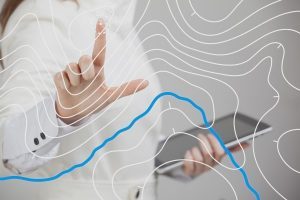On December 4-5, 1884, John Wesley Powell addressed the U.S. Congress seeking authorization for the U.S. Geological Survey (USGS) to begin systematic topographic mapping of the United States. During the next 125 years, terrain mapping techniques evolved from field surveys through photogrammetry to the computer-based methods currently used.
There is no universal usage of the terms digital elevation model (DEM), digital terrain model (DTM) and digital surface model (DSM) in scientific literature. In most cases the term digital surface model represents the earth’s surface and includes all objects on it. In contrast to a DSM, the digital terrain model (DTM) represents the bare ground surface without any objects like plants and buildings.
Today, highly accurate digital elevation can be achieved with light detection and ranging (LIDAR) and interferometric synthetic aperture radar (IfSAR). LIDAR transmits laser pulses that bounce off the Earth’s surface and are measured. IFSAR is a radar technique that uses stereo pairs of radar images and photogrammetric processing to derive the Earth’s surface.
One powerful technique for generating digital elevation models is interferometric synthetic aperture radar where two passes of a radar satellite, or a single pass if the satellite is equipped with two antennas (like the SRTM – Shuttle Radar Topography Mission – instrumentation), collect sufficient data to generate a digital elevation map tens of kilometers on a side with a resolution of around ten meters.
Employing UKA to design and manufacture your lens for digital terrain mapping equipment will ensure that it brings the highest quality possible. From design to production, your job is all done in-house.
Terrain inventory mapping is used for a variety of purposes including but not limited to:
- ecosystem mapping
- terrain stability mapping used to manage landslide risk to values such as water quality, high value habitat, timber resources, utilities and infrastructure, human life and limb, etc.
- erosion potential mapping used to manage risk of sedimentation to values such as water quality, fish habitat, wildlife habitat
- aggregate resources
- till prospecting
- terrain hazards and constraints
- research
- parent materials for soil classification
- watershed assessment
- environmental impact studies
- geological hazard mapping and geological risk assessment
- regional planning (e.g., zoning for official community plans, land and resource management plans)
Digital mapping has the potential to help us understand our solar system more fully. In fact, the first topographic map of Mercury was released in May of 2016 by the U.S. Geological Survey, Arizona State University, Carnegie Institute of Washington, Johns Hopkins University Applied Physics Laboratory and NASA.
Along with that, a study published in Geology describes the first ever comprehensive digital map of our seafloor’s sediment composition, which covers 70 percent of the planet’s surface. The interactive map will not only lead to a better understanding of the ocean floor, but may help predict how the ocean’s environment will respond to climate change.
Universe Kogaku designs and manufactures optical lenses for digital terrain mapping equipment, security, high tech and electronic applications. We stock 1000’s of standard lens assemblies and can custom design a solution for scanners, CCTV, CCD/CMOS, medical imaging, surveillance systems, machine vision and night vision systems.